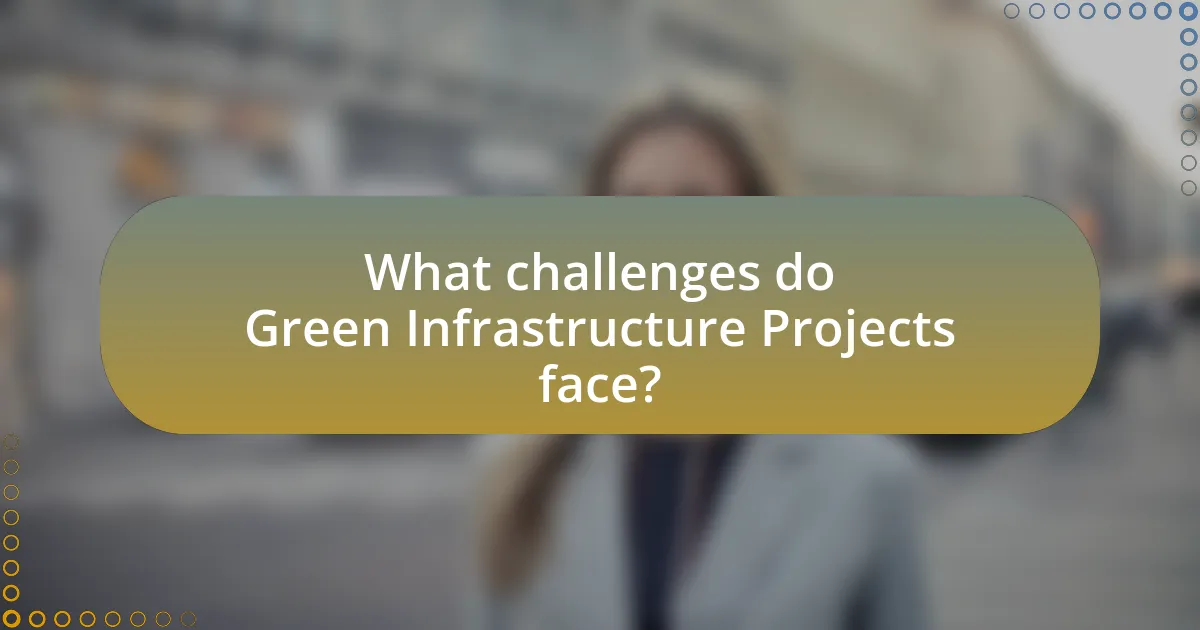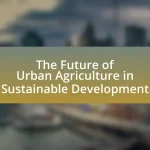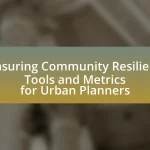Green Infrastructure Projects are initiatives aimed at managing stormwater, enhancing biodiversity, and improving urban environments through natural processes. This article explores various successful green infrastructure projects worldwide, such as the High Line in New York City and the Cheonggyecheon Stream Restoration in Seoul, highlighting their effectiveness in mitigating flooding, improving air quality, and promoting wildlife habitats. It also discusses the differences between green and traditional infrastructure, key characteristics of these projects, challenges faced, and future trends, emphasizing the importance of sustainability and community engagement in achieving successful outcomes.

What are Green Infrastructure Projects?
Green Infrastructure Projects are initiatives designed to manage stormwater, enhance biodiversity, and improve urban environments through natural processes. These projects utilize vegetation, soils, and natural systems to provide ecosystem services, such as reducing flooding, improving air quality, and promoting wildlife habitats. For example, the implementation of green roofs, permeable pavements, and rain gardens in urban areas has been shown to effectively mitigate runoff and improve water quality, as evidenced by studies from the Environmental Protection Agency, which highlight the effectiveness of green infrastructure in urban stormwater management.
How do Green Infrastructure Projects differ from traditional infrastructure?
Green Infrastructure Projects differ from traditional infrastructure primarily in their approach to managing stormwater and enhancing environmental sustainability. While traditional infrastructure typically relies on gray systems like pipes and concrete to control water flow and manage urban runoff, green infrastructure employs natural processes and features such as green roofs, permeable pavements, and rain gardens to absorb and filter rainwater. This method not only mitigates flooding and water pollution but also promotes biodiversity and improves urban air quality. Studies have shown that cities implementing green infrastructure can reduce stormwater runoff by up to 65%, demonstrating its effectiveness compared to conventional methods.
What are the key characteristics of Green Infrastructure Projects?
Green Infrastructure Projects are characterized by their ability to integrate natural systems into urban environments to manage stormwater, enhance biodiversity, and improve air quality. These projects often utilize green roofs, permeable pavements, and urban forests to mimic natural processes, thereby reducing runoff and promoting water infiltration. For instance, a study by the U.S. Environmental Protection Agency highlights that green infrastructure can reduce stormwater runoff by 30-50%, demonstrating its effectiveness in managing water resources sustainably. Additionally, these projects contribute to climate resilience by mitigating urban heat effects and providing habitats for wildlife, further emphasizing their multifaceted benefits in urban planning.
Why is sustainability important in Green Infrastructure Projects?
Sustainability is crucial in Green Infrastructure Projects because it ensures long-term environmental health and resilience. By integrating sustainable practices, these projects can effectively manage natural resources, reduce pollution, and enhance biodiversity. For instance, a study by the U.S. Environmental Protection Agency highlights that sustainable green infrastructure can reduce stormwater runoff by up to 90%, thereby mitigating flooding and improving water quality. This demonstrates that sustainability not only addresses immediate ecological concerns but also fosters community well-being and economic viability over time.
What are the main types of Green Infrastructure Projects?
The main types of Green Infrastructure Projects include green roofs, rain gardens, permeable pavements, urban forests, and constructed wetlands. Green roofs involve vegetation planted on rooftops to manage stormwater and improve air quality. Rain gardens are designed to absorb rainwater runoff, reducing flooding and enhancing biodiversity. Permeable pavements allow water to infiltrate through surfaces, minimizing runoff and promoting groundwater recharge. Urban forests provide shade, improve air quality, and enhance urban aesthetics. Constructed wetlands mimic natural wetlands to treat wastewater and manage stormwater effectively. Each type contributes to environmental sustainability and urban resilience.
What role do green roofs play in urban environments?
Green roofs play a crucial role in urban environments by enhancing biodiversity, improving air quality, and reducing urban heat. These systems provide habitats for various species, contributing to urban biodiversity; studies indicate that green roofs can support up to 30 different plant species and various insects. Additionally, they help filter pollutants from the air, leading to improved air quality, as vegetation absorbs carbon dioxide and releases oxygen. Furthermore, green roofs mitigate the urban heat island effect by lowering surface and air temperatures, with research showing that they can reduce rooftop temperatures by up to 40 degrees Fahrenheit compared to conventional roofs. This combination of benefits makes green roofs a vital component of sustainable urban infrastructure.
How do permeable pavements contribute to stormwater management?
Permeable pavements contribute to stormwater management by allowing water to infiltrate through the surface, reducing runoff and promoting groundwater recharge. This type of pavement is designed with materials that create voids, enabling rainwater to pass through and be absorbed into the underlying soil. Studies indicate that permeable pavements can reduce surface runoff by up to 80%, significantly mitigating flooding and erosion during heavy rainfall events. Additionally, they help filter pollutants from stormwater, improving water quality before it reaches local waterways.

What are some successful Green Infrastructure Projects worldwide?
Some successful Green Infrastructure Projects worldwide include the High Line in New York City, the Cheonggyecheon Stream Restoration in Seoul, and the Bosco Verticale in Milan. The High Line transformed an abandoned elevated railway into a vibrant urban park, enhancing biodiversity and community engagement while attracting millions of visitors annually. The Cheonggyecheon Stream Restoration revitalized a previously covered stream, improving water quality and providing a green space that supports local wildlife and recreation. Bosco Verticale, or Vertical Forest, consists of residential towers adorned with trees and plants, significantly improving air quality and promoting urban biodiversity. These projects demonstrate the effectiveness of green infrastructure in enhancing urban environments and addressing ecological challenges.
What lessons can be learned from the New York City Green Infrastructure Program?
The New York City Green Infrastructure Program teaches the importance of integrating green infrastructure into urban planning to manage stormwater effectively. This program has demonstrated that utilizing green roofs, permeable pavements, and bioswales can significantly reduce runoff and improve water quality. For instance, the program has achieved a reduction of over 1.5 million gallons of stormwater runoff during a typical rain event, showcasing the effectiveness of these strategies. Additionally, the program highlights the necessity of community engagement and collaboration among various stakeholders, which has been crucial for its success and sustainability.
How did the program improve urban resilience?
The program improved urban resilience by implementing green infrastructure solutions that enhanced stormwater management and reduced urban heat. For instance, the installation of green roofs and permeable pavements in various cities has led to a significant decrease in surface runoff, thereby mitigating flooding risks during heavy rainfall events. Studies have shown that cities employing these strategies experienced up to a 30% reduction in flood-related damages, demonstrating the effectiveness of green infrastructure in bolstering urban resilience against climate change impacts.
What specific strategies were implemented in this project?
The specific strategies implemented in this project included the integration of green roofs, rain gardens, and permeable pavements. These strategies were designed to manage stormwater effectively, reduce urban heat, and enhance biodiversity. For instance, the use of green roofs has been shown to lower building energy costs by up to 25% while also improving air quality by filtering pollutants. Rain gardens were strategically placed to capture and absorb runoff, which can reduce flooding and improve water quality by allowing natural filtration. Permeable pavements facilitate groundwater recharge and minimize surface runoff, contributing to sustainable urban drainage systems.
How has Singapore integrated Green Infrastructure into its urban planning?
Singapore has integrated Green Infrastructure into its urban planning by implementing a comprehensive approach that includes green roofs, vertical gardens, and extensive park networks. The city-state has established policies such as the Landscape Replacement Policy, which mandates that developments replace any greenery lost during construction, ensuring that urbanization does not compromise green spaces. Additionally, the Urban Redevelopment Authority promotes the integration of nature into urban environments through initiatives like the Park Connector Network, which links parks and green spaces across the city. These strategies have resulted in over 47% of Singapore being green space, demonstrating a commitment to sustainability and biodiversity within urban settings.
What innovative features are included in Singapore’s approach?
Singapore’s approach to green infrastructure includes innovative features such as extensive vertical gardens, integrated water management systems, and smart urban planning. The vertical gardens, exemplified by the Gardens by the Bay project, utilize a combination of native plants and advanced irrigation techniques to enhance biodiversity and improve air quality. Integrated water management systems, like the Marina Barrage, effectively manage stormwater while providing recreational spaces, demonstrating a dual-purpose design. Additionally, Singapore’s smart urban planning incorporates data analytics and technology to optimize resource use and enhance sustainability, as seen in the Smart Nation initiative, which aims to create a more efficient urban environment. These features collectively contribute to Singapore’s reputation as a leader in sustainable urban development.
How has this impacted biodiversity in the city?
The implementation of green infrastructure projects in the city has significantly enhanced biodiversity by creating habitats for various species. For instance, the introduction of green roofs and urban parks has provided essential nesting sites and food sources for birds and pollinators, leading to increased species richness. Studies indicate that cities with green infrastructure can support up to 30% more bird species compared to those without such initiatives, demonstrating a direct correlation between green spaces and urban biodiversity.

What challenges do Green Infrastructure Projects face?
Green Infrastructure Projects face several challenges, including funding limitations, regulatory hurdles, and public acceptance issues. Funding limitations often arise due to the high initial costs associated with implementing green infrastructure solutions, which can deter investment. Regulatory hurdles can complicate project approval processes, as existing policies may not adequately support innovative approaches. Public acceptance issues stem from a lack of awareness or understanding of the benefits of green infrastructure, leading to resistance from communities. These challenges can hinder the successful implementation and sustainability of green infrastructure initiatives.
What are the common barriers to implementing Green Infrastructure?
Common barriers to implementing Green Infrastructure include high initial costs, lack of technical expertise, regulatory challenges, and insufficient public awareness. High initial costs can deter investment, as projects often require significant upfront funding despite long-term savings. The lack of technical expertise among local governments and stakeholders can hinder effective planning and execution. Regulatory challenges arise from existing policies that may not support innovative practices, creating obstacles for implementation. Additionally, insufficient public awareness can lead to a lack of community support, which is crucial for the success of Green Infrastructure initiatives. These barriers have been documented in various studies, highlighting the need for targeted strategies to overcome them.
How can funding issues affect project success?
Funding issues can significantly hinder project success by limiting resources necessary for execution and completion. Insufficient funding can lead to delays, reduced scope, and compromised quality of deliverables. For instance, a study by the Project Management Institute found that 37% of projects fail due to inadequate funding, which directly impacts timelines and stakeholder satisfaction. Additionally, projects with budget constraints often struggle to attract and retain skilled personnel, further diminishing their chances of success. Therefore, securing adequate funding is crucial for ensuring that projects meet their objectives and deliver intended outcomes.
What role does public perception play in the acceptance of these projects?
Public perception significantly influences the acceptance of green infrastructure projects. When communities view these initiatives positively, they are more likely to support funding, implementation, and maintenance efforts. Research indicates that projects perceived as beneficial to local ecosystems and community well-being garner higher public approval. For instance, a study by the National Recreation and Park Association found that 85% of respondents believed parks and green spaces enhance their quality of life, demonstrating a direct correlation between positive public perception and project acceptance. Thus, fostering a favorable public image is crucial for the successful adoption of green infrastructure projects.
How can these challenges be overcome?
Challenges in implementing green infrastructure projects can be overcome through strategic planning, stakeholder engagement, and leveraging technology. Strategic planning involves assessing local environmental needs and aligning projects with community goals, which enhances public support and resource allocation. Engaging stakeholders, including local governments, community members, and environmental organizations, fosters collaboration and ensures diverse perspectives are considered, leading to more sustainable solutions. Additionally, leveraging technology, such as data analytics and modeling tools, can optimize project design and implementation, ensuring efficient use of resources. For instance, cities like Philadelphia have successfully utilized these strategies in their green infrastructure initiatives, resulting in improved stormwater management and enhanced urban resilience.
What best practices can be adopted for successful project implementation?
Successful project implementation can be achieved by adopting best practices such as thorough planning, stakeholder engagement, and continuous monitoring. Thorough planning involves defining clear objectives, timelines, and resource allocation, which ensures that all team members understand their roles and responsibilities. Stakeholder engagement is crucial as it fosters collaboration and support from all parties involved, leading to better decision-making and resource utilization. Continuous monitoring allows for real-time assessment of project progress, enabling timely adjustments to address any challenges that arise. These practices are supported by research indicating that projects with defined goals and active stakeholder participation have a higher success rate, as evidenced by various successful green infrastructure projects worldwide.
How can community engagement enhance project outcomes?
Community engagement enhances project outcomes by fostering collaboration, ensuring that the needs and preferences of local stakeholders are integrated into project planning and execution. Engaged communities are more likely to support initiatives, leading to increased participation and resource sharing, which can improve project sustainability. For instance, a study by the National Recreation and Park Association found that projects with active community involvement saw a 30% increase in user satisfaction and a 25% increase in long-term maintenance success. This evidence demonstrates that when communities are involved, projects are more likely to meet their intended goals and deliver lasting benefits.
What are the future trends in Green Infrastructure Projects?
Future trends in Green Infrastructure Projects include increased integration of technology, enhanced community engagement, and a focus on climate resilience. The adoption of smart technologies, such as sensors and data analytics, allows for real-time monitoring and management of green spaces, improving their efficiency and effectiveness. Community involvement in the planning and maintenance of these projects fosters a sense of ownership and ensures that the infrastructure meets local needs. Additionally, as climate change impacts become more pronounced, projects are increasingly designed to withstand extreme weather events, emphasizing sustainable practices that promote biodiversity and ecosystem health. These trends are supported by research indicating that cities investing in green infrastructure can reduce urban heat, improve air quality, and enhance overall public health.
How is technology shaping the development of Green Infrastructure?
Technology is significantly shaping the development of Green Infrastructure by enabling innovative design, efficient resource management, and enhanced monitoring capabilities. For instance, the use of Geographic Information Systems (GIS) allows urban planners to analyze environmental data and optimize the placement of green spaces, which has been shown to improve urban biodiversity and reduce heat islands. Additionally, smart sensors and IoT devices facilitate real-time monitoring of water quality and soil health, ensuring that green infrastructure systems, such as green roofs and permeable pavements, function effectively. Research from the National Academies of Sciences indicates that integrating technology into green infrastructure projects can lead to a 30% increase in efficiency in stormwater management systems, demonstrating the tangible benefits of technological advancements in this field.
What role do policy changes play in advancing Green Infrastructure initiatives?
Policy changes are crucial in advancing Green Infrastructure initiatives by providing the necessary regulatory framework and financial incentives for implementation. For instance, policies that promote sustainable land use and water management can facilitate the integration of green infrastructure practices, such as green roofs and permeable pavements, into urban planning. Evidence from cities like Philadelphia, which adopted the Green City, Clean Waters program, shows that policy reforms can lead to significant investments in green infrastructure, resulting in improved stormwater management and enhanced urban resilience. These changes not only encourage public and private sector collaboration but also foster community engagement, ultimately driving the successful adoption of green infrastructure solutions.
What practical tips can be applied to develop successful Green Infrastructure Projects?
To develop successful Green Infrastructure Projects, it is essential to engage stakeholders early in the planning process. Early stakeholder engagement fosters collaboration and ensures that the needs and concerns of the community are addressed, which is critical for project acceptance and sustainability. Additionally, conducting thorough site assessments helps identify the unique environmental conditions and challenges of the area, allowing for tailored solutions that enhance ecological benefits.
Implementing a phased approach to project development allows for adjustments based on feedback and performance evaluations, ensuring that the project remains effective over time. Utilizing native plant species in landscaping not only supports local biodiversity but also reduces maintenance costs and water usage. Furthermore, securing diverse funding sources, including public-private partnerships, can enhance financial stability and resource availability for the project.
Evidence from successful projects, such as the High Line in New York City, demonstrates that integrating community input and adaptive management strategies leads to long-term success and resilience in Green Infrastructure initiatives.


